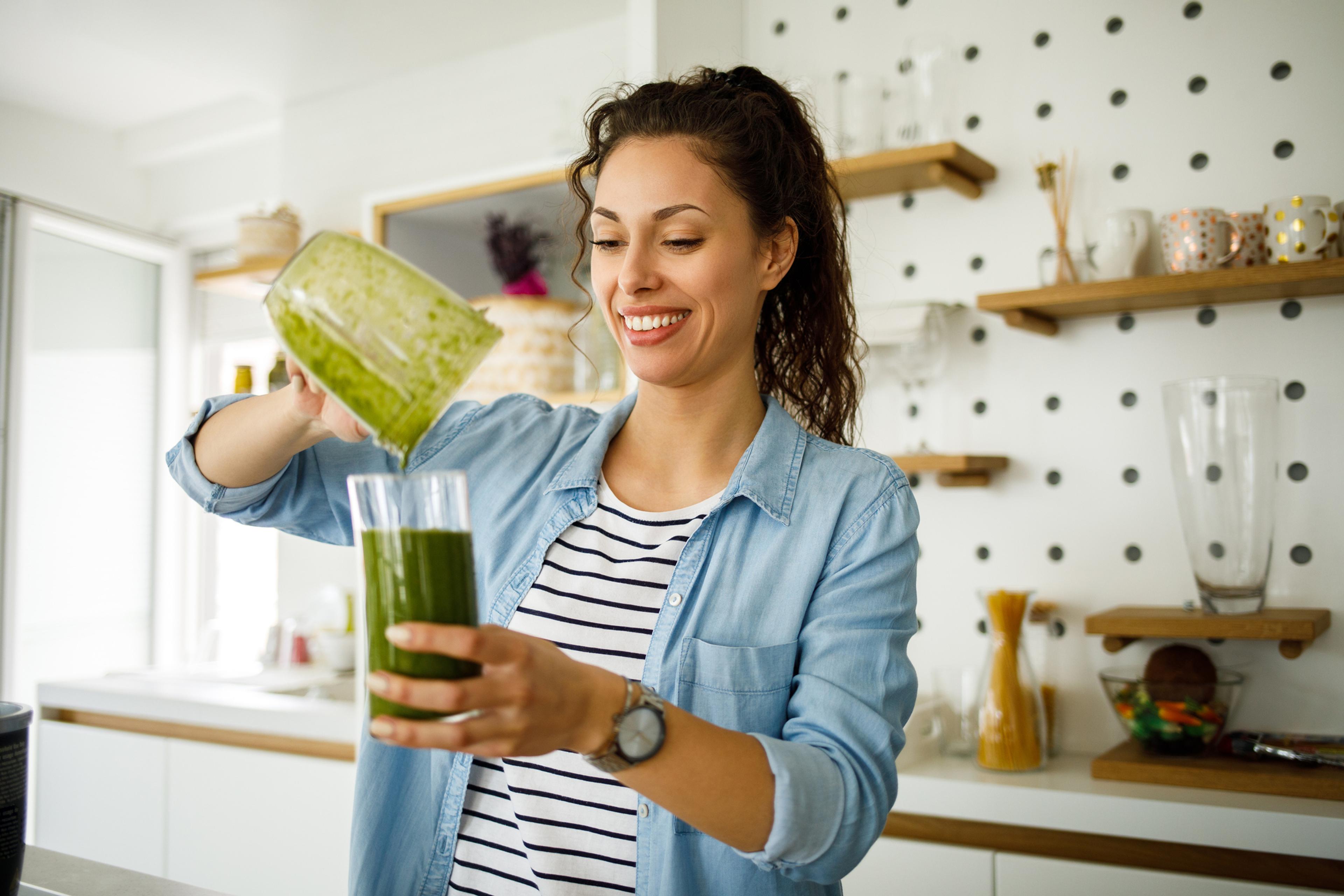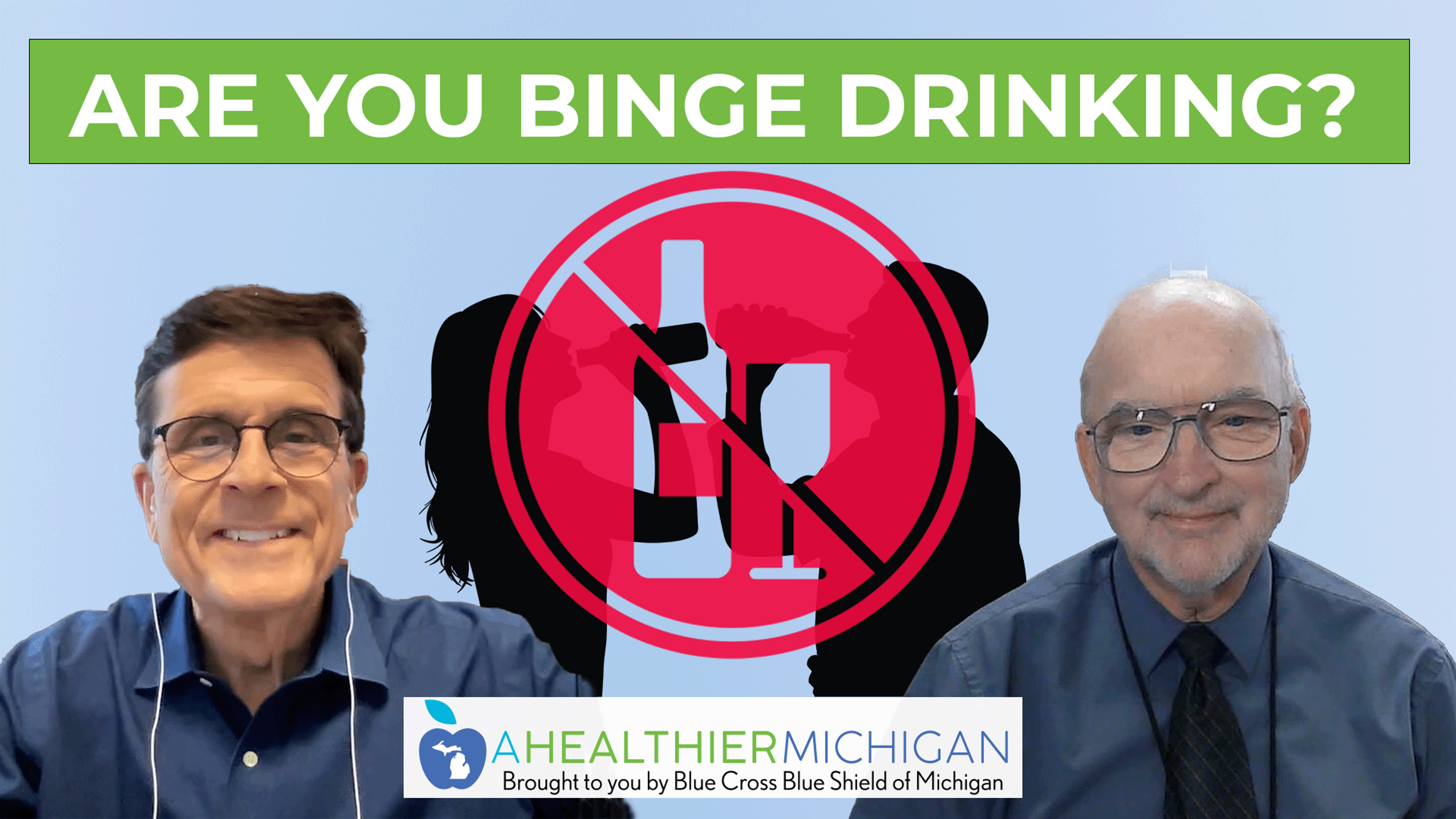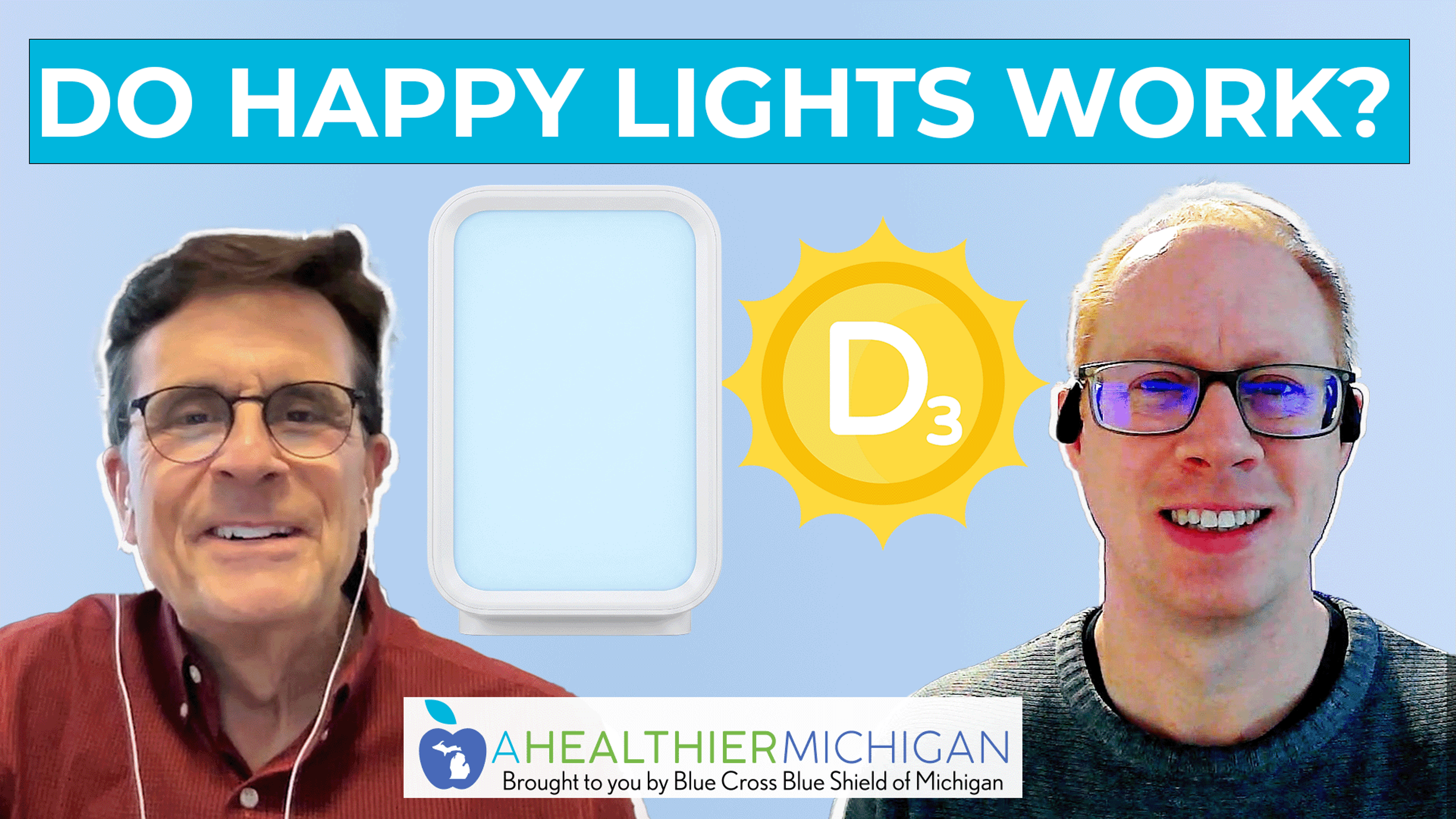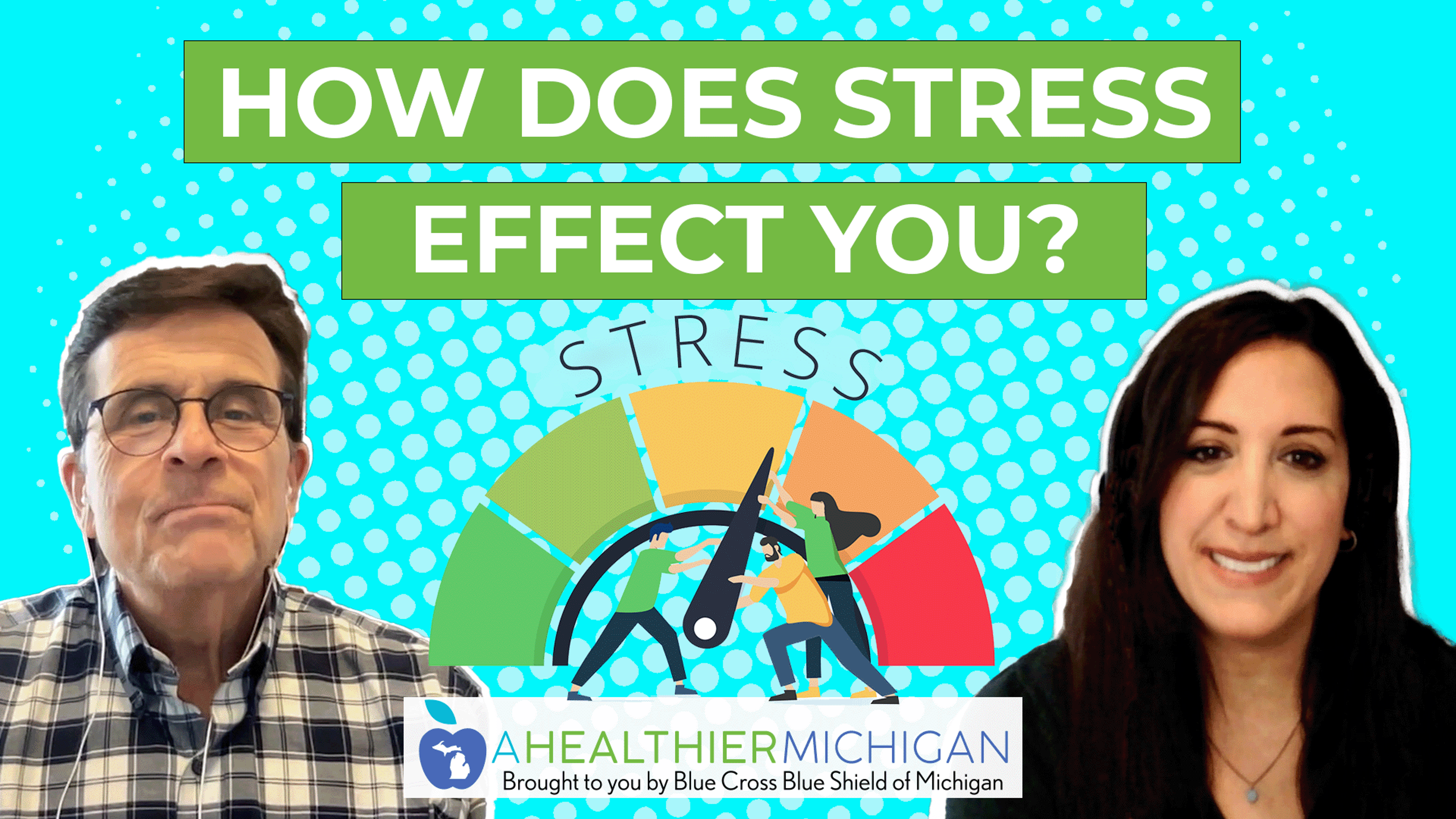Easy Ways to Increase Your Veggie Intake
| 1 min read

00:00
00:00
About the Show
On this episode, Chuck Gaidica is joined by Shanthi Appelö, registered dietitian for Blue Cross Blue Shield of Michigan. Together, they discuss how we can incorporate more veggies into our diet.
In this episode of A Healthier Michigan Podcast, we explore:
- The recommended daily servings of vegetables
- Effects of getting your daily servings and the impact of not getting enough vegetables a day
- Ways to increase your veggie intake
- How to make vegetables more palatable
Transcript
Here is the full transcript of this episode. You can listen to the audio version on streaming platforms or watch on YouTube.
Chuck Gaidica:
Did you know only 1 in 10 adults eat the daily recommended amount of vegetables? This is A Healthier Michigan Podcast, episode 143. Coming up, we discuss easy and creative ways to increase your veggie intake.
Did you know only 1 in 10 adults eat the daily recommended amount of vegetables? This is A Healthier Michigan Podcast, episode 143. Coming up, we discuss easy and creative ways to increase your veggie intake.
Welcome to A Healthier Michigan Podcast. It's a podcast dedicated to navigating how we can all improve our health and wellbeing through small, healthy habits we can start implementing right now.
I'm your host, Chuck Gaidica. Every other week we'll sit down with a certified expert, And we discuss topics that cover nutrition, like today. We go into fitness and a whole lot more.
I'm your host, Chuck Gaidica. Every other week we'll sit down with a certified expert, And we discuss topics that cover nutrition, like today. We go into fitness and a whole lot more.
On this episode we're taking a dive into how we can all incorporate vegetables. Oh, some people go, "Yeah." And some are like, "Ahh, I don't like broccoli." How do we incorporate more vegetables into our diet?
With us today, Shanthi Appelö, who's a registered dietician and apparently dog mom to Benny. Look at Benny.
Shanthi Appelö:
He's just my little support.
Chuck Gaidica:
Does Benny know Benny's on camera and part of a podcast, do you think?
Shanthi Appelö:
He's always this cute. He does put it on thick a little bit for the camera sometimes.
Chuck Gaidica:
That's awesome. Well, right after this, we'll hear that he's got an agent and that he needs a trailer.
How are you doing? You doing all right?
Shanthi Appelö:
Good. You know what I was thinking when you said 1 in 10 adults get enough vegetables? What's interesting to me about that is that as adults, we push vegetables so much on children, and then we're not doing it for ourselves.
Chuck Gaidica:
Right.
Shanthi Appelö:
So we could definitely be doing better in that arena. But I don't think it has to be that difficult.
Chuck Gaidica:
Well, that's such an interesting point. Because you know I know, and you probably can relate, this is something that we talk to our kids about all the time: "Eat all your veggies."
And of course, that sometimes goes hand-in-hand with other activities, like, "Make sure you clean your plate." That's a whole different episode. But it's likely some of us have used that statement on our kids.
Why is that? Why is it that we aren't eating the veggies ourselves? It's not just because we're so busy preparing; because obviously, we're sitting down a lot at the same time.
Shanthi Appelö:
And we're willing to prepare it for the kids, because they need that for their good health. Right?
Chuck Gaidica:
Yeah.
Shanthi Appelö:
But it goes much past the development phase in terms of why we need vegetables. They have so many important nutrients that I think even become especially important as we get older, as we're trying to live longer, healthier lives.
They have so many antioxidants. They have these polyphenols, which fancy name for plant compound that we don't quite understand what they are yet. There are so many of them out there. But they can do so much good for our bodies in terms of preventing cancer, preventing chronic illness.
There's also this component of them that's naturally lower in calories, high in fiber. So we tend to eat less energy-dense foods as a result.
So all that said, there's so much good to be had, but we don't do it.
Chuck Gaidica:
Well, that's interesting. And these stats are not just things we're pulling out of the air, right? The CDC says 91% of adults are not getting the daily recommended amount of vegetables.
So I guess that's a good jumping-off point for my first question: what is the recommended serving of vegetables per day for an adult?
Shanthi Appelö:
Yeah, fruits and vegetables tend to get grouped together as the 5 A Day. But technically, the recommendation for adults is going to be about three servings of vegetables. It does vary by age.
For example, toddlers, about a cup is recommended. Kids up to eight years old, two-and-a-half cups. It varies in those younger years, but three a day is what we should shoot for.
And when we think about it, it's a good opportunity to fit that into our life. Because most people have three-ish meals in a day: breakfast, lunch, and dinner. So if we can set a goal to do it once each meal, that's a good one.
Chuck Gaidica:
But when we say that, when you talk about that ... And I'm glad you said "servings." Because really, when I think about eating the average three a day, I'm thinking, "Oh, well, I've got to have three different vegetables." You're saying, "servings." So if I love green beans, I could triple up on them, I guess, and I would still qualify. Right?
Shanthi Appelö:
Definitely. Yeah.
Chuck Gaidica:
How do I get vegetables in my breakfast?
Shanthi Appelö:
Personally, I really love eating open-face sandwiches for breakfast. I find that putting a load of lettuce on there, chopping up some bell peppers, having some tomato slices, and just filling it up with that kind of stuff is an easy way for me to pack in vegetables at breakfast, paired with some kind of meat or egg or whatever have you.
That can be a really easy way for people who like eggs: doing an omelet and chopping vegetables into it, whether it be bell peppers or spinach, making them make their way into it.
I also recently put up a recipe on A Healthier Michigan that are kind of faux sous vide egg bites. You make them in a muffin tin in the oven. And why some people tend to like that is that they have texture issues. The veggies just melt into the sous vide egg bite, if you will. So I think there's a lot of ways you can be creative in the morning.
Chuck Gaidica:
That's interesting. Now you use avocado toast as qualification there for adding veggies, right?
Shanthi Appelö:
Definitely. And you know what's great about avocado? That it's so surprising to a lot of people, is that one single avocado can have 10 grams of fiber. We don't think of it as a very fibrous vegetable because it's very fatty. And of course, that's something to pay attention to, and maybe not something you want to overdo. But it does have so many important nutrients in there. It can be kind of nature's mayo.
Chuck Gaidica:
You will be so proud of me. Shanthi, you will say, "Chuck, you need an award." Because today for lunch, I had tomato soup and I had avocado toast. That's why it was top of mind. That was it. That was the deal.
And I'm not usually all veggies, but it was kind of comfort food. It's not mac and cheese, but it was a delightful way of having comfortable food for lunch.
Shanthi Appelö:
I love that, and I love that you're saying that it's comfort food. Vegetables can still be part of that comfort food. And I think people can make tomato soup the way they need to.
I think it gets a bad rap sometimes. But there are so many healthy ways to make tomato soup without adding too much heavy cream or sweetness, and just rely on the fiber itself and the tomato itself when you roast them.
Chuck Gaidica:
Yeah, this was not a bisque. This was just good old-fashioned tomato soup. So I think I've reignited my passion for it, now that I've had it again.
So when you think about this idea of vegetables; good and bad, getting enough, not getting enough; what are the effects of getting your daily servings of vegetables?
You mentioned some of the things that are in there. But what effects would we actually begin to see or feel in our bodies over time? Because it's not just going to happen when you have an ear of corn.
Shanthi Appelö:
Right, right. There's some interesting research published in the journal Circulation two years ago, so 2021.
Actually, this was a group of different studies that they looked at, but basically pulled together 2 million people to look at vegetable intake specifically.
They found that people who ate just two servings of fruits and vegetables each day compared to people who ate five. So people who ate five had 13% lower risk of death from any cause; 12% lower risk of death from heart disease or stroke; 10% lower risk of death from cancer; and a 35% lower risk from death from respiratory disease. So COPD kind of thing.
That was in an article shared by Harvard. But I thought that was really interesting. Because when you ask what are the differences, oftentimes we can't feel them right away. But in terms of our life and our longevity, it is something that makes a big difference.
Now, if we don't have enough vegetables in the short term, that could look a little bit different. They do provide very important nutrients, like fiber we talked about. That's actually another nutrient that Americans don't get enough of.
If we look at fiber recommendations, 25 grams are recommended for women, 38 grams are recommended for men. But as a country, we tend to, on average, only consume about 15 grams a day. So falling very, very short: half of what's recommended for men.
Fiber does give us that, right? And so fiber is a very vital part of digestion. Maybe if you're not consuming enough vegetables, you can end up constipated. You could feel sluggish; because if you're not eating vegetables, what are you eating? Maybe more ultra-processed foods that aren't going to make you feel great. Maybe if you're not eating vegetables, you're not getting a lot of potassium. So it could increase the risk for muscle cramps.
Chuck Gaidica:
Well, and it's ironic to me that a lot of the supplements that people will see ... I was just shopping the other day, and I'm walking through the pharmacy side of the big box store. I see fiber additives and other things. And I'm in the vitamin section, so I'm seeing this stuff. I see vegan this and vegan that and plant-based.
I'm thinking, "That may be part of the issue: that just like we are with our food, we would rather somebody grind it up, make it a powder, put it in a capsule, or put it in a container, and I just have to mix it up with a glass of water."
I know certain people have certain issues they need to supplement that way. But I thought that's really interesting that now, "Well, instead of making the green beans, I'm just going to have somebody grind them up and throw them in a little gelatin thing. I'll take one and that's it. I'm done."
Shanthi Appelö:
Yeah. I think we like an easy way out sometimes. And I think for a lot of people it may be that they're like, "Well, maybe I'm not consuming enough today. I'm going to take one just in case to make sure I get what I need." I think there's a spectrum of people who take supplements for different reasons.
But one thing to note is that these nutrients that are in vegetables do work better in their actual food source. I know that we've talked a little bit about this in a supplement episode, but one example I like to give is betacarotene.
They've looked at betacarotene as a supplement, and they've looked at betacarotene in their natural source, like in carrots and all of our orange ... It's almost pumpkin season ... those kind of nutrients.
So in its food form, it's found to be preventive of different types of cancers. But in supplement form, when it's consumed in excess, it can increase the risk for certain cancers in people who have been previous smokers.
So nutrients can actually work in synergy with each other in their food. And sometimes we don't know what they're acting in synergy with. That's why it's so important to focus on food first. Because even though we don't know exactly why, we do see that our body uses the nutrients better than it would in supplement form.
Chuck Gaidica:
So how can we increase our veggie intake every day?
Shanthi Appelö:
Well, I like to set a goal. Because sometimes when we don't have a goal or a plan for how we approach our meals, it may be less likely to be that way. So if we have a goal that we consume one vegetable at each meal, it's much more likely to happen: even if you're going out to eat, or whatever you may have in the back of your head.
"Well, I do have a goal to have one vegetable for each meal. I'm going to make sure that one of my side items is a vegetable," or something like that.
I think also, if you're someone who doesn't eat vegetables at all, just recognize that increasing by just one serving a day can make a difference. So you don't have to go from zero to a hundred; instead just adding a little bit at a time.
Maybe expanding your palate; maybe when you're going out to eat with friends or something, ordering things that seem a little bit different that you may not order usually, and see maybe if you're interested in; or may like vegetables that you've never tried before.
Chuck Gaidica:
Well, or vegetables that become a main entree that you can share if you're looking to experiment. Right? That's a great idea.
Shanthi Appelö:
I love that. Yeah. And it can be easy things, too. If you like hummus and you want to eat them on a cracker, but you don't really love the veggies, it's super easy just to blend in some beets.
I know we have a recipe like that on A Healthier Michigan, and also roasted carrots that go beautifully into a hummus, too.
Chuck Gaidica:
So what are some creative ways that you've adapted in your own life, and others you can counsel us about, about adding vegetables to dishes?
Shanthi Appelö:
Yeah, I am very passionate about making vegetables taste good. Because if they don't taste good, we're not likely to eat them. And I'm not one to force-feed myself just because I know it's good for me.
So if you're someone who just doesn't like vegetables, regardless of how they're cooked, I think smoothies are a great opportunity to add them. For example, avocado goes great into a smoothie. Cauliflower even tends to not have a lot of flavor, but it adds a ton of fiber and antioxidants and nutrients. Spinach, kale; those are all really great ways to pack that in.
Chuck Gaidica:
Interesting.
Shanthi Appelö:
Yeah. With green leafy vegetables, they have been found to be particularly beneficial in a few different realms of health.
For example, for heart health, they've been shown to be really protective. Then in recent years, for example, the mind diet that's focused on preventing cognitive decline: they recommend a special focus on green leafy vegetables. So something to pay attention to.
Chuck Gaidica:
I never would think in a million years of throwing cauliflower into a smoothie shake. But you're right, it's pretty nondescript stuff.
Shanthi Appelö:
Yeah. It doesn't have that distinct, "Okay, this is a cauliflower smoothie." You're going to cover it up with all the berries and all the other stuff.
My second pointer is that there are certain vegetables that you may not know need to be cooked a certain way.
For example, I have a friend; we were having a late night snack one day watching TV. And I was like, "You know what? We should make some asparagus."
And she's like, "Ew, why? Why would we ever have asparagus?"
And I'm like, "No, I promise: it's so good if you cook it right." She had only had asparagus where you would pick it up and it would be all sad.
Chuck Gaidica:
Yeah. Yeah.
Shanthi Appelö:
And maybe it would have this sad color to it.
Anyway, my key to anything that's a salt-free vegetable like cauliflower, broccoli, asparagus, is to put them under a preheated broiler. You toss them in some oil, salt and pepper and just do about seven minutes.
That way, they get crisp and a little bit of color on the outside. They still get cooked on the inside, but not overdone. And then you can put any kind of seasoning after, because they would burn under the broiler.
Chuck Gaidica:
Did you get any other reaction besides, "Ew"?
Shanthi Appelö:
I'm so excited to tell you that! She says it's her absolute favorite vegetable now.
Chuck Gaidica:
Come on.
Shanthi Appelö:
And she lives very far away from me, but she makes it all the time. It's like a snack for her now.
Chuck Gaidica:
But that's one of those things that when you are ... Well, you were an influencer, right? I mean, you know what you're up to.
But it's the same for broiling. Whatever it is, broccoli, you can have whatever you want to use. And it can be something that you've never thought of before.
Shanthi Appelö:
Yeah, absolutely. Yeah. And I think too, with people who have texture issues and stuff, think about the size of your stuff. I think the more uniform the size of your vegetables are in a salad, the more pleasant it is to eat.
You may also want to think about, for example, if you're into sauces and soups and things like that ... I love tomato soup, like you mentioned earlier ... making a mirepoix: a mix of celery, carrots, and onions. Those are all great vegetables.
Whenever you cook it like a mirepoix, they get really softened and nice; and sometimes they just kind of blend into your food. So the strategies we like to do for kids sometimes, to hide the vegetables.
Chuck Gaidica:
You could run that through a food processor or a little blender, if you're really looking to thicken something up, or just to have it add in there, and not really know that it's in there.
Shanthi Appelö:
Exactly. Ooh, one more thing that I love to do, especially in the summer or late summer: is use herbs as the star of the show, because they do have a lot of similar nutrients to vegetables.
I like to make chimichurries, different salsa, sauces, arugula pesto; there are so many different ways that you can make herbs the star of the show. Of course, you're adding a little bit of oil and things like that, but generally those are going to be heart healthy.
But that's a really great way to just kick up the flavor, and also kick up the nutrients of just about anything.
Chuck Gaidica:
There are a whole bunch of guys that are potentially listening to this that are thinking, "See? The experts said we should have a lot of salsa on Sunday for football." But okay, it's vegetables. It is.
Shanthi Appelö:
Yeah. Yeah. I mean, asparagus dipped in whatever solves that. Yep.
Chuck Gaidica:
So as we wrap it up, what are the takeaways? We've covered a lot of ground today.
Shanthi Appelö:
Yeah. I think, set a goal. Figure out where you're at with your vegetable intake. Recognize that they are super important to your health.
And then finally, just go out and experiment. Maybe try some of these techniques that we talked about today. If you haven't tried broiling some of your vegetables, try it that way.
If you've never massaged your kale, make sure you're doing that before you have a salad, but just get creative.
Chuck Gaidica:
I don't ever massage kale. Wait a minute. This is a whole new ... Have you mentioned this before?
Shanthi Appelö:
Maybe. But my kale loves a massage, and it deserves it.
Chuck Gaidica:
Well, they don't have shoulders. What do you mean? You're just going to rub it together between your fingers?
Shanthi Appelö:
Oh my goodness. So start with a bowl. I usually get kale that's already been chopped. I pick out the thick bits, because usually those taste quite bitter.
And when it's only the lettuce left, just a little bit of olive oil drizzle, a little bit of nice massage. About 20 seconds is what you want to do. And then it's the most tender, delicious thing.
And after that, you can do any kind of dressing if you want. But oftentimes, you won't need that much after the oil.
Chuck Gaidica:
Oh, this is a new thing. I've never heard of such an idea. But I guess I'm going to talk nice to my kale, and I'm going to give them a little shoulder massage before.
Shanthi Appelö:
It can't hurt. Right?
Chuck Gaidica:
Yeah, right. Right. Well, thanks, Shanthi. Good to see you.
Shanthi Appelö:
Thanks.
Chuck Gaidica:
Shanthi Appelö has been with us. You've been listening to A Healthier Michigan Podcast, brought to you by Blue Cross Blue Shield of Michigan.
If you like the show, you want to know more, you can check us out on the newly refreshed ahealthiermichigan.org/podcast. You heard Shanthi saying she's posted there. You can also leave us reviews or ratings on Apple Podcast or Spotify.
We've also got a YouTube channel. You can catch our episodes that way as well, with the video. So that's kind of nice; you can still take all of that with you, no matter where you go: walking or riding or just sitting in the house.
You can also follow us on Facebook, Instagram, or Twitter. And you can always get new episodes, old episodes on your smartphone or tablet. Be sure to subscribe to us, huh? On Apple Podcast, Spotify, or your favorite podcast app.
I'm Chuck Gaidica. Be well.





